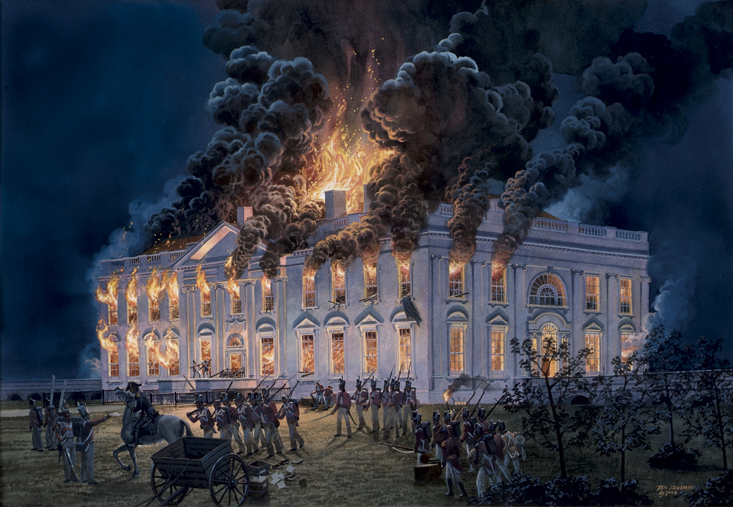Washington is burned.
November 7, 2013 at 3:34 pm sgopher 2 comments
Sam Operchuck
11-7-13

The Burning of Washington
The Burning of the Capital.
The year of 1814 saw many difficulties for America, specifically the current war with Great Britain. As British moved up the Chesapeake Bay, the heat of the summer was immense, turning nearby marshes “into thriving hatcheries for disease-carrying mosquitoes.” Until the defeat of Napoleon, the Crown didn’t have it’s full attention on fighting the United States. However, when Napoleon was defeated, England turned towards America with full force. British troops landed in the Chesapeake Bay and a force of approximately 4,000 marched on Washington towards the Nation’s capital. The majority of the inhabitants fled, yet a messenger was sent to the white house to warn the first lady, Dolley Madison, and she quickly packed as many crucial documents into bags and fled with the house staff. “That evening, the vanguard of the British army reached Capitol Hill and began its systematic destruction of all public buildings in the city.” The Capital was entirely burned out, as was the original plot by the British. The entire assumption that this mission rested on was the hope of fully deflating the fighting spirit behind the American people. Much to the Crown’s surprise, this endeavor instead strengthened America’s determination to fight. All said, little was accomplished for either side during the war, although it did serve to slightly enhance America’s economy by forcing Americans to produce things that were previously imported.
Plans for the reconstruction of Washington began quickly after the fires had been smothered, as men such as Henry Latrobe were summoned to restore the Capital Building. However, changes in the government influenced changes in the architecture of key buildings: “Changes in Congress prompted changes in the building’s interior. Chief among these were eight new rooms in the north wing for Senate committees. Latrobe also enlarged the House and Senate chambers, modifying their layout to better suit their operations. In plan and decoration, these spaces recalled the classical architecture of ancient Greece and Rome. To ensure that the work was both elegant and economical, one of the sculptors returned to Italy—where labor was cheaper—to supervise the carving of column capitals.”
The question then, is whether the entire reconstruction of Washington was productive or not. I would tend to believe that it was. Because of the times, America was still in an immense time of growth both physically and principally. Especially with the drastic idea of the peaceful transaction of power not only between individuals but between individuals of opposing parties, many precedents were being set for future America. With that came the creating of principles (such as the Constitution) as well as the amendment of ideas as they were “put to the test”. Although the fires did indeed cause quite a wound to the Nation’s Capital, it gave the country a moment to reflect and answer the question of “if we could change things, what would we change?” and thus provided an opportunity to implement those changes. Ultimately, just as a forest fire provokes growth, I believe the fire of the Capital also produced growth as a country.
CITATIONS
http://www.eyewitnesstohistory.com/washingtonsack.htm
http://www.visitthecapitol.gov/exhibition-hall/timeline?story=1307
Entry filed under: Uncategorized.
2 Comments Add your own
Leave a comment
Trackback this post | Subscribe to the comments via RSS Feed
1. dwood07022013 | November 7, 2013 at 4:54 pm
dwood07022013 | November 7, 2013 at 4:54 pm
Were the columns built in Italy and then shipped to America or were the columns simply inspired by the ones he witnessed being built in Italy.
2. vebramos | November 8, 2013 at 8:32 am
vebramos | November 8, 2013 at 8:32 am
Why wouldn’t the reconstruction of our capital be productive? i mean that’s our capital.